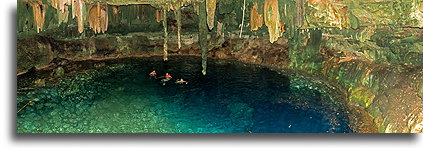Mayapan and Cenote
October 15


It was our third night at Uxmal. The whole time we were the only people who stayed overnight at the camp near the ruins. It was a very calm place. Time has come to say goodbye to Uxmal and hit the road. Our first stop of the day was Mayapan, an important Postclassic city in the northern Yucatán Peninsula.



The end of the Classic period in Maya history is marked by the abandonment of cities, the end of many dynasties and the northward migration of the population. All that happened around the AD 1000. Some cities, however, survived to Postclassic period. One of them was Chichen Itza. Initially dominant in this area, it was conquered in the 13th century and lost its significance. The newly built city of Mayapan became the dominant power of the region. Its leading role lasted until the first half of the 15th century. Because of the rebellion, almost all members of the ruling family were killed. The consequence was the destruction and abandonment of Mayapan. On the eve of the Spanish conquest, without leading power, Yucatan devolved into warring city-states.



Kukulcan Temple is the tallest and most important structure in Mayapan. Archaeologists found stucco covered fragments of human skulls here. That suggests that this was a place of practices related to the death cult. There are also three round temples in Mayapan, which is quite unusual for the Maya. Unlike in nearby Chichen Itza and many other cities of the Classic period, there are no traditional ballcourts in Mayapan.


We wanted to see our first cenote. We chose the less visited one, located far away from other Yucatan attractions. To reach Cenote Kankirixche, we went to the town of Mukuyche, and from there a short dirt road to Kankirixche. At the gate we paid a small entrance fee, such places are always in private hands, and the locals require an entrance fee.


The natural sinkhole is the result of the collapse of the surface layer. When such a collapse reveals groundwater, we get a cenote. There are many of them in Yucatan Peninsula. For the ancient Maya it was the only source of drinking water, because there are no rivers in this area. Many ancient Maya cities were built near such natural wells. The Maya believed that cenote is a passage to the Xibalba or the Underworld. The Maya threw valuable items into the cenote. In some of them archaeologists found sacrificial objects and human bones.




Our next stop was Hacienda Temozón, once one of the most important livestock haciendas in the region. It dates from 1655. Like many other haciendas, the original owners of this estate were the descendants of the conquistador who conquered Yucatan for the Spanish crown. This place was restored with the attention to the detail and today functions as a hotel. It was not difficult to imagine the leisurely life and luxury surrounding the former owners. The original machinery, small railroad cars, and narrow gauge railway tracks reminded us of the bygone era and the hard labor of Maya forced to work here.



Interesting is to mention a fact that Hacienda Temozón was visited by two US presidents invited here by the Mexican counterparts. Bill Clinton was invited for an “anti-drug” summit in 1999. George W. Bush visited Temozón in 2007.













